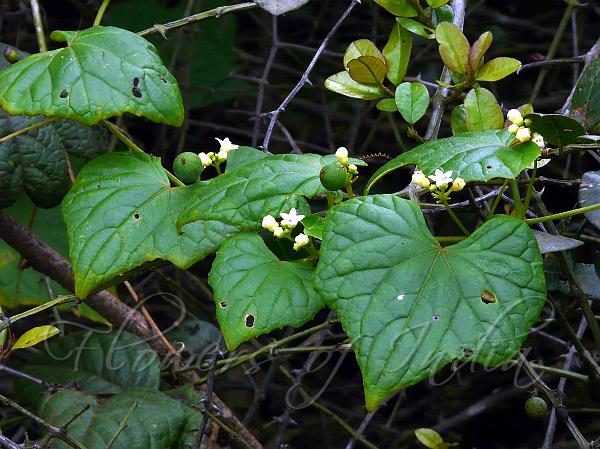|
| Asian Zehneria |
|

|

| File size | 740442 |
| Original date | 9/28/08 2:32 PM |
| Resolution | 2048 x 1536 |
| Flash | Flash did not fire, auto |
| Focal length | 23.7mm |
| Exposure time | 1/250s |
| Aperture | 5.0 |
| Focus Distance | |
| Metering Mode | Multi-segment |
| Camera make | Panasonic |
| Camera model | DMC-FZ18 |
| Sensor type | OneChipColorArea |
|
|
|
|
Photo: |
Botanical name: Zehneria bodinieri Family: Cucurbitaceae (Pumpkin family)
Synonyms: Melothria bodinieri, Pilogyne bodinieri
Synonyms: Melothria bodinieri, Pilogyne bodinieri
Asian Zehneria is a climbing plant, named
for Emile Marie Bodinieri, 19th century French missionary in China who
collected plants. Stem and branches are slender, grooved-angular,
hairless or sparsely velvet-hairy. Leaf-stalks are slender, 2-5 cm,
hairless; leaf blade broadly ovate or rarely triangular-ovate, 4-12 x
3-10 cm, membranous, below nearly hairless, above scabrous, basal sinus
semicircular, rarely nearly flat, margin wavy-finely toothed, undivided
or sometimes shortly 3-5-lobed, tip pointed or shortly tapering.
Tendrils are thread-like, simple, hairless. Male flowers are often 3-9
in a head-like or cymose inflorescence; flower-cluster-stalk slender,
1-4 cm, hairless; flower-stalks 1-4 mm; sepal-cup tube bell-shaped, 2-3
× 1-2 mm, hairless or finely velvet-hairy; segments narrowly
triangular, about 0.5 mm; flower white; segments ovate or ovate-oblong,
2-2.5 mm, below finely velvet-hairy, tip subpointed; stamens two
2-celled, one 1-celled, sometimes all 2-celled, inserted at base of
sepal-cup tube; filaments about 2 mm, finely velvet-hairy; anthers
ovoid, 0.6-0.7 mm. Female flowers solitary, rarely a few in an umbel;
ovary ovoid. Fruiting flower-stalks are slender, 0.5-1 cm, hairless;
fruit red when ripe, baccate, spherical, 1-1.4 cm in diameter, smooth.
Asian Zehneria is found in India to S. China and Philippines.
Flowering: April-August.
| Identification credit: Mayank Dhar Dwivedi | Photographed at Kas Plateau, Satara, Maharashtra. |
• Is this flower misidentified? If yes,